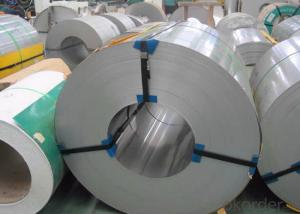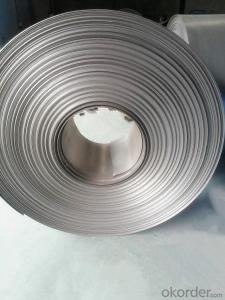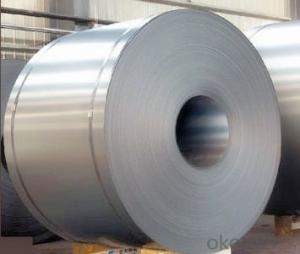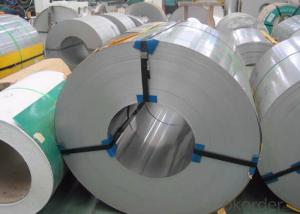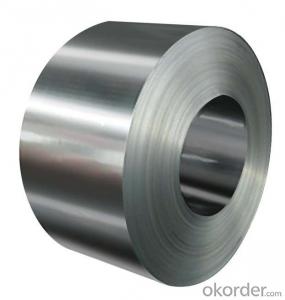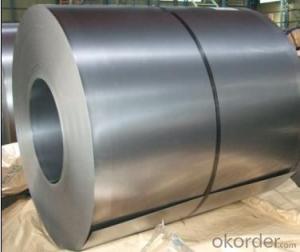201 SERIOUS STAINLESS STEEL COILS/SHEETS
- Loading Port:
- Shanghai
- Payment Terms:
- TT OR LC
- Min Order Qty:
- 50 m.t.
- Supply Capability:
- 20000 m.t./month
OKorder Service Pledge
Quality Product, Order Online Tracking, Timely Delivery
OKorder Financial Service
Credit Rating, Credit Services, Credit Purchasing
You Might Also Like
Specifications
1,2b 201 stainless steel coil thickness0.2~1.5mm
2.Ensure you quality timely delivery
3.2B finish
4.Tolerance 0.01mm
JMSS cold rolled 2b 304 stainless steel coil
Item Details:
1, 2b 304 stainless steel coil with thickness 0.2~1.5mm
2, Finishing: 2B
3, Width: 15~500mm
4. Tolerance: -0.01mm~0.01mm
- Q: What are the factors affecting the creep resistance of 111 stainless steel strips?
- The factors affecting the creep resistance of 111 stainless steel strips include the alloy composition, grain size, temperature, and applied stress. The presence of elements like chromium, nickel, and molybdenum enhances creep resistance. A fine grain structure enhances resistance, while higher temperatures and applied stresses can reduce the creep resistance of the stainless steel strips.
- Q: What are the different sizes available for stainless steel strips?
- The sizes available for stainless steel strips can vary depending on the supplier and the specific requirements of the project. However, some common sizes range from thin strips with a width of 0.2 inches (5mm) to wider strips with a width of 12 inches (300mm) or more. The thickness of the strips can also vary, typically ranging from 0.01 inches (0.25mm) to 0.2 inches (5mm) or more. It is important to consult with a supplier to determine the exact sizes available for stainless steel strips.
- Q: Can stainless steel strips be used for kitchen appliances?
- Yes, stainless steel strips can be used for kitchen appliances. Stainless steel is a commonly used material for kitchen appliances due to its durability, resistance to corrosion, and easy cleaning properties. Stainless steel strips can be used for various applications in kitchen appliances such as handles, trims, or decorative elements.
- Q: Can stainless steel strips be used in the automotive industry?
- Yes, stainless steel strips can be used in the automotive industry. They are commonly used for manufacturing components such as exhaust systems, decorative trims, and structural parts due to their durability, corrosion resistance, and ability to withstand high temperatures.
- Q: Can stainless steel strips be formed into coils or rolls?
- Yes, stainless steel strips can be formed into coils or rolls. Stainless steel strips are typically produced in coil form and can easily be wound into a coil or roll shape. This makes them convenient for transportation, storage, and further processing. The process of forming stainless steel strips into coils or rolls involves a combination of bending, coiling, and winding techniques, which allow for the creation of compact and tightly wound stainless steel coils. These coils or rolls can then be used in various applications such as manufacturing, construction, automotive, and many others. The ability to form stainless steel strips into coils or rolls adds to their versatility and makes them a popular choice in many industries.
- Q: Is the stainless steel condiment bottle good for rotating or for all holes?
- Generally divided into martensitic stainless steel, ferritic stainless steel, austenitic stainless steel, duplex stainless steel and precipitation hardening stainless steel, etc., or divided into chromium, stainless steel and nickel stainless steel two categories.
- Q: Can stainless steel strips be used in the production of HVAC grilles?
- Yes, stainless steel strips can be used in the production of HVAC grilles. Stainless steel is a popular material choice for HVAC grilles due to its durability, corrosion resistance, and aesthetic appeal. The use of stainless steel strips in the production of HVAC grilles ensures that the grilles will be able to withstand the harsh conditions of heating, ventilation, and air conditioning systems without rusting or deteriorating over time. Additionally, stainless steel strips offer a sleek and modern appearance, making them an ideal choice for architectural and design purposes. Overall, stainless steel strips are a suitable and reliable option for manufacturing HVAC grilles.
- Q: Are stainless steel strips suitable for architectural roof cladding?
- Indeed, architectural roof cladding can be effectively accomplished with stainless steel strips. Thanks to its exceptional durability and resistance to corrosion, stainless steel proves to be an optimal choice for outdoor installations like roof cladding. It endures inclement weather conditions, such as rain, snow, and UV radiation, without succumbing to degradation or compromising its aesthetic appeal. Furthermore, architects can select from a diverse array of finishes and colors, providing them with ample options to achieve their desired design aesthetic. The versatility, strength, and minimal upkeep demands of stainless steel strips render them an exceptional option for architectural roof cladding.
- Q: Can stainless steel strips be used in the production of jewelry findings?
- Yes, stainless steel strips can be used in the production of jewelry findings. Stainless steel is a popular choice for jewelry findings due to its durability and corrosion resistance. It is commonly used for components such as clasps, jump rings, earring hooks, and bead caps. Stainless steel strips can be easily shaped, cut, and formed into various jewelry findings, making them suitable for a wide range of designs. Additionally, stainless steel has a sleek and modern appearance, making it a sought-after material in contemporary jewelry.
- Q: How do stainless steel strips resist corrosion?
- Stainless steel strips resist corrosion due to the presence of chromium in their composition. When exposed to oxygen, a thin layer of chromium oxide forms on the surface of the steel, creating a protective barrier that prevents further oxidation and corrosion.
Send your message to us
201 SERIOUS STAINLESS STEEL COILS/SHEETS
- Loading Port:
- Shanghai
- Payment Terms:
- TT OR LC
- Min Order Qty:
- 50 m.t.
- Supply Capability:
- 20000 m.t./month
OKorder Service Pledge
Quality Product, Order Online Tracking, Timely Delivery
OKorder Financial Service
Credit Rating, Credit Services, Credit Purchasing
Similar products
Hot products
Hot Searches
Related keywords














